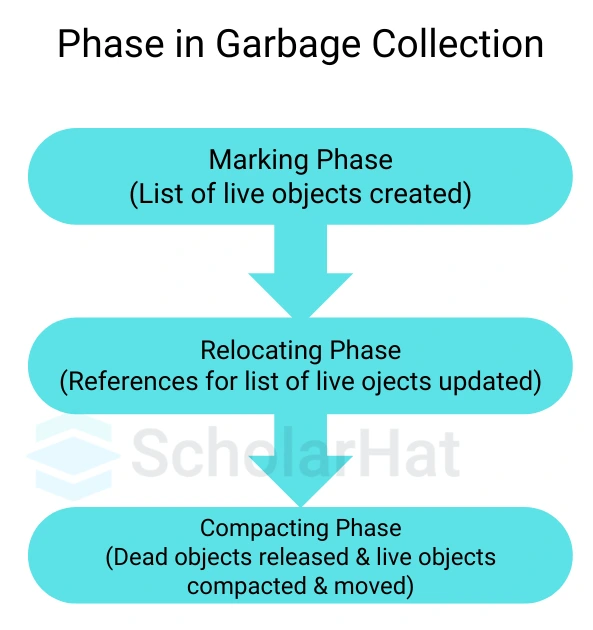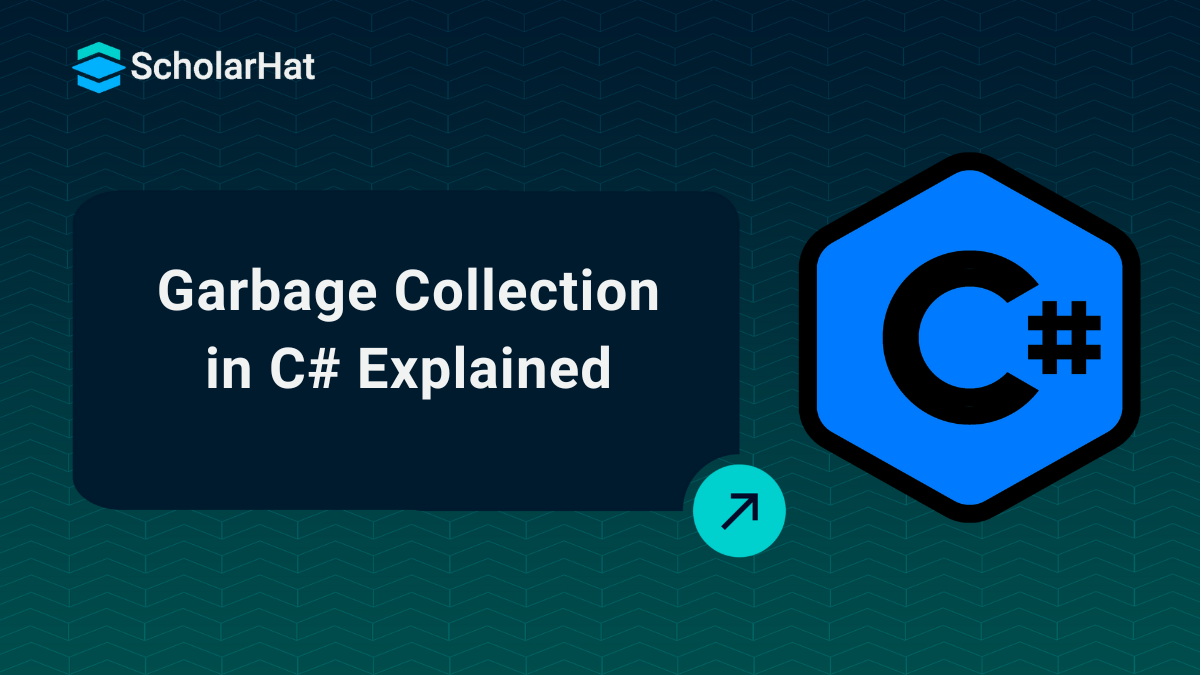18
AprIntroduction to Garbage Collection in C#
Garbage Collection in C#
Garbage Collection in C# refers to the process by which the Common Language Runtime (CLR) automatically reclaims memory that is no longer in use by an application. You know how when you finish a task, it feels fantastic to clear your desk and make way for new items? That's basically what Garbage collection does in C#. It automatically cleans up memory that your software no longer requires. It not only keeps your software running smoothly but also minimizes memory leaks.
So, In this C# Tutorial, we will explorewhat garbage collection is in C#including How Garbage Collection Works in C#. To gain a deeper understanding of this concept and more, you can enroll in a C Sharp Course Free and enhance your skills today!
How Garbage Collection Works in C#
The Garbage Collector in C# takes a generation-based approach, dividing things into distinct generations based on their lifespan.
- Generation 0:This generation stores short-lived objects that are often collected fast.
- Generation 1:Generation 1 holds objects that have survived at least one garbage collection.
- Generation 2: ItContains long-lived objects that persist for a longer duration.
The GC identifies objects that are no longer reachable, marks them for collection, and frees up the memory they occupy.
Heap Generations in Garbage Collection
The Garbage Collector (GC) in C# uses a generational collection strategy to optimize memory management. The heap is divided into three generations:
1. Generation 0 (Gen 0)
This is where newly created, short-lived objects are stored. These objects are collected frequently because most of them quickly become unreachable. Example: temporary objects like local variables in methods.
2. Generation 1 (Gen 1)
Generation 1 holds objects that survived one garbage collection in Generation 0. It acts as a buffer between short-lived and long-lived objects.
3. Generation 2 (Gen 2)
This generation contains long-lived objects, such as global variables or objects that stay in memory for extended periods. It is collected less often to avoid performance overhead.
Key Methods in the GarbageCollector Class
- GC.Collect(): Forces garbage collection to occur. You can specify a generation to collect.
- GC.GetTotalMemory(): Returns the total memory currently allocated.
- GC.MaxGeneration: Returns the maximum number of generations (usually 2).
- GC.GetGeneration(): Returns the generation of a specific object.
- GC.SuppressFinalize(): Prevents the finalizer from being called on an object.
- GC.WaitForPendingFinalizers(): Suspends the thread until finalizers are completed.
GC.Collect(); // Full GC GC.Collect(0); // Collect Generation 0 long memoryUsed = GC.GetTotalMemory(false); int maxGen = GC.MaxGeneration; int gen = GC.GetGeneration(myObject); GC.SuppressFinalize(myObject); GC.WaitForPendingFinalizers();Sample Program
Here’s a simple program that demonstrates garbage collection and generation handling:
using System;
class Program
{
static void Main(string[] args)
{
// Display total memory used before object creation
Console.WriteLine("Memory before creating objects: {0} bytes", GC.GetTotalMemory(false));
// Create a large number of objects in Generation 0
for (int i = 0; i < 10000; i++)
{
object obj = new object();
}
// Display memory used after creating objects
Console.WriteLine("Memory after creating objects: {0} bytes", GC.GetTotalMemory(false));
// Force garbage collection of Generation 0
GC.Collect(0);
Console.WriteLine("Memory after GC.Collect(0): {0} bytes", GC.GetTotalMemory(false));
// Create an object and check its generation
object genObject = new object();
Console.WriteLine("Generation of genObject: {0}", GC.GetGeneration(genObject));
// Force full garbage collection (all generations)
GC.Collect();
Console.WriteLine("Memory after full GC.Collect(): {0} bytes", GC.GetTotalMemory(false));
// Suppress finalization for an object
GC.SuppressFinalize(genObject);
Console.WriteLine("Generation of genObject after suppression: {0}", GC.GetGeneration(genObject));
// Display the maximum number of generations
Console.WriteLine("Max Generation: {0}", GC.MaxGeneration);
}
} Output Example
Memory before creating objects: 13000 bytes
Memory after creating objects: 23000 bytes
Memory after GC.Collect(0): 14000 bytes
Generation of genObject: 0
Memory after full GC.Collect(): 13000 bytes
Generation of genObject after suppression: 0
Max Generation: 2
Phases of Garbage Collection
Garbage Collection typically follows these three phases:

- Marking: Identifies which objects are still reachable and marks them as alive.
- Relocating: Moves live objects to fill the gaps left by dead objects.
- Compacting: Compacts memory to reduce fragmentation, ensuring efficient future allocations.
Generational Collection in Action
The GC typically starts with Generation 0. If there’s still not enough memory after collecting Generation 0, it proceeds to Generation 1, and finally Generation 2 if necessary.
When Does Garbage Collection Occur?
Garbage Collection in C# occurs in the following scenarios:
- Memory Allocation: When memory is low, the GC is triggered to free up space.
- Manual Invocation:You can manually trigger GC using GC.Collect(), though it is generally discouraged.
- Application Idle Time: The GC may run during idle periods to optimize memory usage.
key features of the garbage collector in C#
1. Automatic Memory Management
The Garbage Collector (GC) automatically manages memory allocation and deallocation, eliminating the need for developers to manually free memory. This reduces the likelihood of memory-related bugs like leaks and crashes.
2. Generational Collection
The GC organizes objects into three generations, focusing on short-lived objects first for more efficient memory management:
- Generation 0: Holds short-lived objects and is collected frequently.
- Generation 1: Stores objects that have survived Generation 0 collection.
- Generation 2: Contains long-lived objects, collected less often.
3. Compaction and Memory Optimization
After collecting objects, the GC compacts memory to eliminate gaps left by dead objects, reducing fragmentation and making memory allocations faster.
4. Mark-and-Sweep Algorithm
The GC uses a mark-and-sweep algorithm, where it marks live objects and sweeps away objects that are no longer reachable, reclaiming their memory.
5. Background and Concurrent Garbage Collection
The GC can run in the background or concurrently with your program’s execution, reducing interruptions and improving overall application performance.
6. Large Object Heap (LOH) Management
The GC manages large objects separately in a special Large Object Heap (LOH). This reduces the performance impact when handling large memory allocations.
7. Finalization Support
C# provides support for finalization, allowing objects to release unmanaged resources (such as file handles or network connections) before being collected by the GC.
8. Manual Garbage Collection
Although the GC is automatic, developers can manually invoke it using the GC.Collect() method. However, this should be done cautiously, as frequent manual collection may negatively affect performance.
9. Low-Latency Modes
The GC provides low-latency modes for high-performance or real-time applications where minimizing GC interruptions is critical.
10. Efficient Memory Allocation
The GC optimizes memory allocation for new objects, making the allocation process fast and minimizing overhead in most scenarios.
Advantages of Garbage Collection
Key benefits of garbage collection include:
- Automatic Memory Management: Developers are freed from manual memory allocation and deallocation.
- Memory Leak Prevention: GC automatically reclaims memory from unused objects, preventing memory leaks.
- Efficient Generational Collection: By focusing on short-lived objects, the GC works efficiently.
- Application Stability: Proper memory management reduces crashes and slowdowns due to excessive memory consumption.
Best Practices for Optimizing Garbage Collection
Though automated, you can optimize memory management with the following practices:
- Minimize Large Object Allocations: Large objects are more expensive to collect and store in a special Large Object Heap (LOH).
- Reduce Object Creation: Avoid creating unnecessary objects, especially in loops or frequently called methods.
- Explicitly Dispose of Objects: Use the IDisposable interface and the Dispose() method to release unmanaged resources.
- Use GC.Collect() Sparingly: Manually triggering garbage collection can harm performance and should be done carefully.
Read More: If you are preparing for the C# exam or interview "Top 50 C# Interview Questions and Answers "Might help you.
Conclusion
Garbage Collection in C# simplifies memory management, helping developers avoid common issues such as memory leaks and fragmentation. With its generational approach, C# GC optimizes performance by focusing on short-lived objects. By following best practices, you can further optimize the efficiency of garbage collection in your applications. Consider our .NET Certification training because it provides a comprehensive understanding of C# programming language.
FAQs
Take our Csharp skill challenge to evaluate yourself!

In less than 5 minutes, with our skill challenge, you can identify your knowledge gaps and strengths in a given skill.








